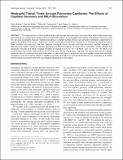Neutrophil Transit Times through Pulmonary Capillaries: The Effects of Capillary Geometry and fMLP-Stimulation
Author(s)
Bathe, Mark; Shirai, Atsushi; Doerschuk, Claire M.; Kamm, Roger Dale
DownloadBathe_Neutrophil transit.pdf (725.8Kb)
PUBLISHER_POLICY
Publisher Policy
Article is made available in accordance with the publisher's policy and may be subject to US copyright law. Please refer to the publisher's site for terms of use.
Terms of use
Metadata
Show full item recordAbstract
The deformations of neutrophils as they pass through the pulmonary microcirculation affect their transit time, their tendency to contact and interact with the endothelial surface, and potentially their degree of activation. Here we model the cell as a viscoelastic Maxwell material bounded by constant surface tension and simulate indentation experiments to quantify the effects of (N-formyl-l-methionyl-l-leucyl-l-phenylalanine (fMLP)-stimulation on its mechanical properties (elastic shear modulus and viscosity). We then simulate neutrophil transit through individual pulmonary capillary segments to determine the relative effects of capillary geometry and fMLP-stimulation on transit time. Indentation results indicate that neutrophil viscosity and shear modulus increase by factors of 3.4, for 10[superscript −9] M fMLP, and 7.3, for 10[superscript −6] M fMLP, over nonstimulated cell values, determined to be 30.8 Pa·s and 185 Pa, respectively. Capillary flow results indicate that capillary entrance radius of curvature has a significant effect on cell transit time, in addition to minimum capillary radius and neutrophil stimulation level. The relative effects of capillary geometry and fMLP on neutrophil transit time are presented as a simple dimensionless expression and their physiological significance is discussed.
Date issued
2002-10Department
Massachusetts Institute of Technology. Department of Biological Engineering; Massachusetts Institute of Technology. Department of Mechanical EngineeringJournal
Biophysical Journal
Publisher
Elsevier
Citation
Bathe, Mark, Atsushi Shirai, Claire M. Doerschuk, and Roger D. Kamm. “Neutrophil Transit Times through Pulmonary Capillaries: The Effects of Capillary Geometry and fMLP-Stimulation.” Biophysical Journal 83, no. 4 (October 2002): 1917–1933. © 2002 The Biophysical Society
Version: Final published version
ISSN
00063495
1542-0086